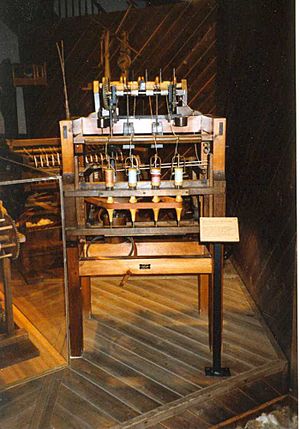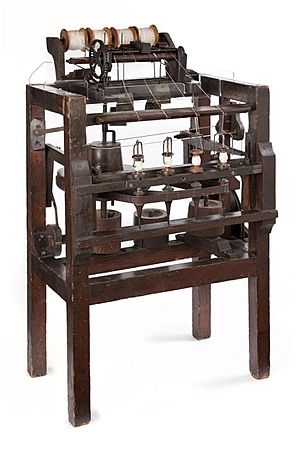Water frame facts for kids
The water frame was a special machine used for spinning thread. It was powered by a water-wheel, which made it very strong and efficient. This invention was a big step forward during the Industrial Revolution, helping to create factories as we know them today.

How the Water Frame Changed Things
Water frames, in a general sense, have been around for a very long time, even since Ancient Egypt. However, Richard Arkwright made a very important version for making cotton thread. He got a patent for his design in 1769. His machine was first used in 1765.
The Arkwright water frame could spin 96 threads at once! This made spinning much easier and faster than ever before. Arkwright's design was partly based on a machine built for Thomas Highs by a clockmaker named John Kay. Arkwright hired Kay to help him.
Because it used water power, the water frame made stronger and tougher yarn than the popular "spinning jenny" of that time. This new machine helped start the modern factory system.
Another water-powered machine for making textiles was created in 1760. It was made in a town called Elberfeld, in what is now Wuppertal, Germany. A German bleach plant owner named Johann Heinrich Bockmühl developed it.
The name water frame comes from using a water wheel to power many spinning machines. The water wheel gave much more power than people could. This meant fewer people were needed, and many more threads could be spun at once. However, unlike the spinning jenny, the water frame could only spin one thread at a time until 1779. That's when Samuel Compton combined the two inventions into his spinning mule, which was even better.
The first water frame was actually powered by horses at a factory Arkwright built in Nottingham. But in 1770, Arkwright and his partners built a mill in Cromford, Derbyshire, that used water power.
The Cromford Mill Story
In 1771, Arkwright put his water frame machines into his cotton mill in Cromford, Derbyshire. This mill was built next to the River Derwent. It was one of the very first factories built especially to hold machines, not just to bring workers together.
At Cromford Mill, the working day was decided by the clock, not by how much daylight there was. People were also employed by the factory, rather than just being hired for a single job. In its final form, when combined with Arkwright's carding machine, it was the first factory to use a continuous process. This meant raw material went in one end and came out as a finished product in a series of steps.
Arkwright played a huge part in creating the factory system. He brought together water power, the water frame, continuous production, and modern ways of employing people.
Spreading Around the World
The water frame was very important for the Industrial Revolution. It started in England, but soon spread to other parts of Europe. A German businessman named Johann Gottfried Brügelmann found out how the secret technology worked. Sharing these details was very risky back then!
Brügelmann managed to build working water frames. He used them to open the first spinning factory on the continent in 1783. It was in Ratingen, Germany, and was also named "Cromford." From there, the technology spread across the world. Today, that factory building is a museum where you can see a working water frame.
Samuel Slater brought the water frame to America. He got around England's 1774 ban on textile workers leaving the country by memorizing how the machine was built. He left for New York in 1789. Moses Brown and Slater worked together to create the Slater Mill in Pawtucket in 1793. This was the first water-powered machine to make thread in America.


